Microsoft Flight Simulator is a once-in-a-generation wow moment
Taking to the skies with the most striking looking game of the year.
Of course, the first thing I do in the new Microsoft Flight Simulator is fly over my house. Heading out from London City Airport in the nimble, aerobatic Extra 330LT, and up into the late evening sky to see the sun melt into the horizon. Skimming The O2, then grazing the tips of Canary Wharf's mob of skyscrapers before banking left over the Isle of Dogs, buzzing the Royal Naval College as we head up over Greenwich Park and then Blackheath as London blooms into parkland south of the Thames.
Then it's simply a case of looking out for the cluster of buildings that marks Lewisham to the right, dipping right then left once again to pick up the Waterlink Way. And there it is. My home. In a video game, for what I'm pretty sure is the very first time. I step away from the controls and out into my garden, slightly dizzy from it all, only to see the sky has darkened to the exact same shade of hazy blue as the one I was just flying through.
Microsoft Flight Simulator isn't the first game to pull in real-world map or weather data to make for a more authentic simulation, nor is it the first game to try and bring us the entire world. But there's an alchemy here that goes beyond bullet point feature lists or plain numbers, blending together to create one of those rare wow moments that come along once a generation, or that maybe herald the next. This really is a phenomenal thing.
Think of Microsoft and video games and you might think that Halo's the flagship, though I've often thought Flight Simulator is where you'll find its real heart. It predates Windows - the first entry came back in 1982, though you can trace its heritage back even further to Bruce Artwick's pioneering work in the late 70s - and is as quintessentially Microsoft as Encarta: an open-armed, technically astute piece of software that offers an education in the pleasures and particulars of flight. And, for one reason or another, the last entry in the series was Flight Simulator X back in 2006.
"I mean, we did have Microsoft Flight in the middle of it all," Microsoft's head of Flight Simulator Jorg Neumann says in wry reference to 2012's failed reboot. "I don't know if flight simulators went out of fashion as such. We always re-evaluate priorities - I wasn't actually around back in 2007, but when [Flight Simulator X developer] Aces Team essentially was divested, the priorities were just different. It was very much about Xbox. Maybe that was the reason. But Flight Sim X was certainly a very successful product, both critically and financially. So I don't think that was the reason - our focus just shifted over to console."
This new Microsoft Flight Simulator is of course intended for console at some point - though there's no real further detail on an Xbox release just yet - but first and foremost it's a continuation of the PC's longest-running series, and built upon the foundation of Flight Simulator X. "The idea was to understand everything that had been written, and with a lot of respect to the team that did that," Martial Bossard, lead technical engineer at Asobo, the lead developers of Flight Sim 2020, tells us. "We had the chance to talk to some of these guys - and to select layers to improve. You'll find a lot of code from Flight Simulator X in there, even right now."
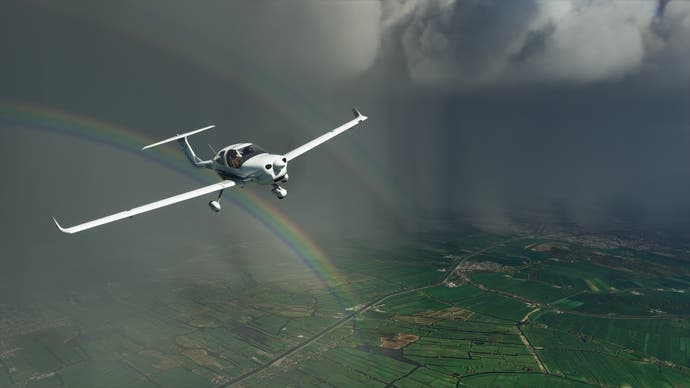
Indeed, why would you throw away something that's supported by a community of players and third-party developers that's still thriving some 14 years on? "We benefited a tonne from that because basically, from day one, the sim worked," says Neumann. "We just made it better one layer at a time. We stood on this wonderful platform and we try to try to improve it wherever we go."
There's even a legacy mode that lets you play with the older simulation model while enjoying all the visual splendour that's now been layered on top, and for Flight Simulator X veterans there's a commitment to make sure some of the more intricate set-ups are supported from day one. "The idea was to try as much as possible not to break anything," says Bossard. "The goal was to always improve, never break."
Of course, the immediately apparent improvement is in the visuals, a fascinating blend of machine learning, real-world map and weather data, plus some smart streaming technology that combines for one of the most visually arresting games of the moment. It's an unashamed focus of this new Microsoft Flight Simulator, and according to Neumann was the number one request from the community. "The thing that came out from simmers was they were actually quite happy in their flight sim space," he says. "But they all said the same thing - why is it that we are so far behind things like Forza? That was interesting! And it was all about visuals - I was like, we can do that!"
Do that they have, as you'll know if you've seen any of the trailers in the run-up to Microsoft Flight Simulator. It is an astonishingly pretty thing, with fulsome self-shadowing clouds depositing tangible volumes of rain that, if caught by a sun that also makes for dazzling dawns and dusks, can create volumetric rainbows. It's backed up with detail that conspires to make something that looks utterly real; skyscrapers cast shadows over each other that darken as you reach street level, cities disperse light at night that radiates the sky, while attention has been paid to make sure the colour temperature of street lights is appropriate.
Head away from the cities and you might discover some of the world's great mountain ranges where air currents whip up the slopes, or maybe head to the ocean and witness waves foaming against tropical islands, where water's behaviour is subject to the weather and the wind. Head even further down to the ground and the grass sways to the same forces, while casting the gentlest green glow upon the underside of your plane. Microsoft Flight Simulator can be as beautiful as the earth itself.
Which might be because Microsoft Flight Simulator's aim is to provide as faithful a recreation of the earth itself as possible. You've likely seen the numbers, and impressive they are: there are some 37,000 airports, an entire world it'd take some 14 years to see from the seat of a Cessna and one that contains some two whole petabytes of data, all told. Not that you'll have to store all that yourself, of course, with Flight Simulator's world delivered via streaming technology (it will be perfectly possible to play offline, with the procedural part of Asobo's magic doing the heavy lifting, though there won't be quite the same amount of detail as if you were playing with a connection).
It's not a perfect recreation, of course, with buildings being pulled from types, the type determined by a matrix of data from Bing Maps and machine learning so that the brickwork or architectural style is about right. Look back at the flight from London City to Lewisham and you'll see that Cesar Pelli's pyramid-capped One Canada Square is now a nondescript skyscraper, and while I didn't get quite close enough to check I'm fairly sure the shed out the back of my house where I've been playing Flight Sim these past few weeks isn't there. The illusion holds, though, even when flying at low altitude - compare it to a contemporary sim such as X-Plane 11 and, even with Orbx's excellent TrueEarth add-on enabled, it's a whole world away.
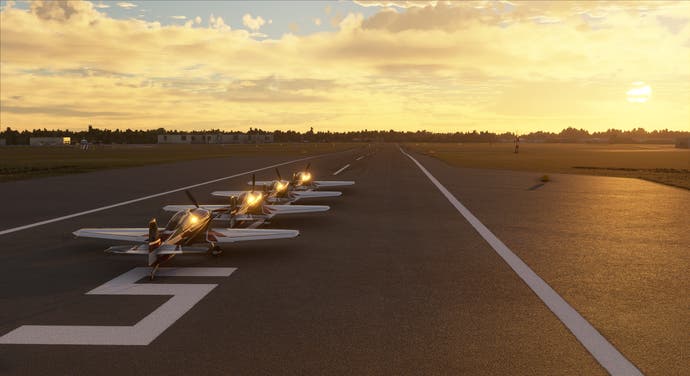
Something like X-Plane 11 is a hard-edged, unashamed sim, of course - though despite it's massively increased marketing budget and place in the mainstream, so too is Microsoft Flight Simulator. "We basically said from the get go, this is a sim for simmers," says Neumann, perhaps wary of the mistakes made by Microsoft Flight. "Make no mistake about it. Because if you're not holding on to what the fibre of what Flight Simulator is, you get confused." Indeed, the sim side runs as deep and is often as staggering as the efforts to make the world believable. I'm no aviation expert with only a couple of hours of flight time under my belt, but these planes, whether it's a goliath Boeing 747 or more sprightly Icon A5, feel legit.
The new flight model's a marked improvement over Flight Simulator X, with air shears and drafts more pronounced thanks to better aerodynamics modelling, combined with more surface points per plane being simulated. Ground effect plays a bigger factor as you descend, providing a soft cushion that's much appreciated if you've just had a landing gear failure that forces you to attempt a belly landing. Or maybe you'll take that Icon A5 and attempt a water landing on any of the planet's bodies of water, and then proceed to take off from that same point too.
In the cockpit, there's the dizzying array of functioning dials and instruments with often mysterious purposes, each there to be prodded and poked as you work through the exhaustive, exhausting checklist of procedures that need to be run through before getting airborne. Or, you could not. That deliciously nerdy, astonishingly detailed side of Microsoft Flight Simulator is there - as it should be, lest they incur the wrath of my nephew who draws out by hand his own flight checklist before every excursion he takes in Flight Simulator X - but there's also the option to have a virtual co-pilot do all the busywork, cueing you up at the end of the runway with little more to worry about than your throttle, yoke and rudders.
If you've ever been lucky enough to fly yourself, you'll know that rush you get when you're first given control and you realise that not only is the act of flying yourself as exhilarating as you'd hoped, it's actually not all that difficult to grasp. Flying in Microsoft Flight Simulator is freeing and fun, and perfectly possible without an encyclopedic knowledge of aviation law and a PhD in aerospace engineering. I've even guided a Boeing 747 into the skies from Heathrow with nothing more than an Xbox controller - and at a certain point, it's possible to just engage the autopilot, kick back and enjoy the flight. If you feel bold enough to land there are prompts, assists and racing-line-style virtual overlays to help bring you safely to ground.
There's even the lightest throughline provided by way of a flight school and missions in the shape of landing challenges and bush trials that have you navigating your way through the wilderness. Or you could play it as the sandbox Microsoft Flight Simulator has always intended to be. Take whatever plane takes your fancy, spin the globe and take off from anywhere in the world - maybe somewhere you've always dreamed of visiting, or maybe somewhere a bit more local so you can get the new sense of home that flight gifts you. And then, you ask yourself - where next?




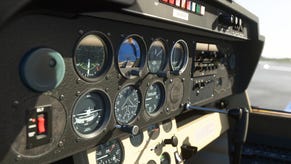
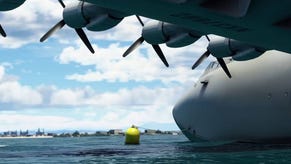

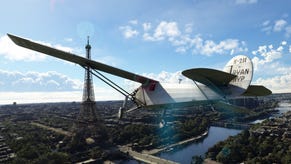



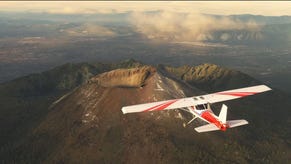

.png?width=291&height=164&fit=crop&quality=80&format=jpg&auto=webp)




.jpg?width=291&height=164&fit=crop&quality=80&format=jpg&auto=webp)
